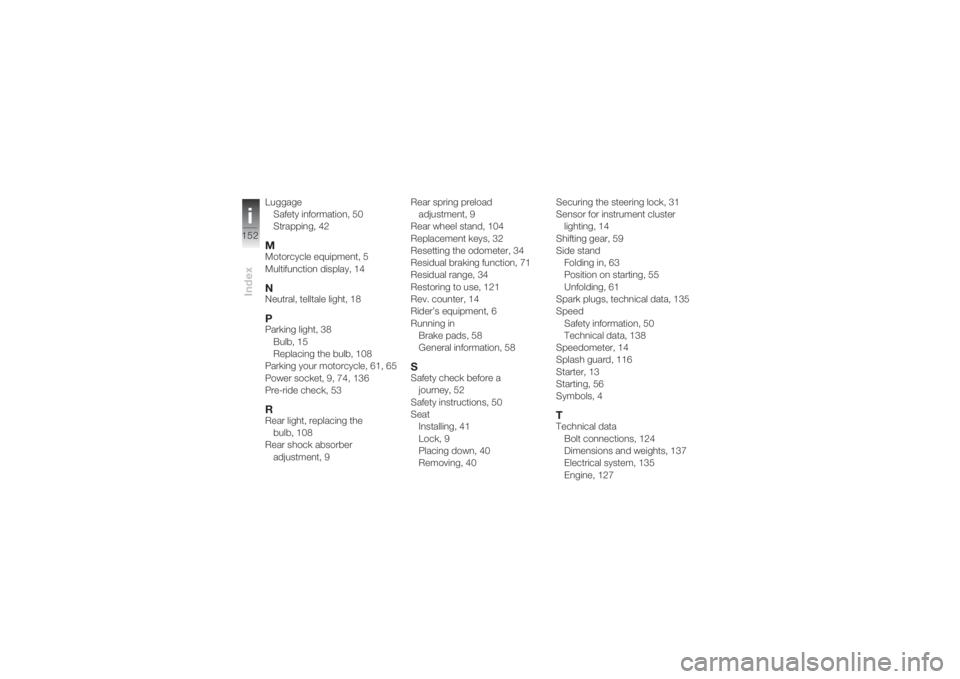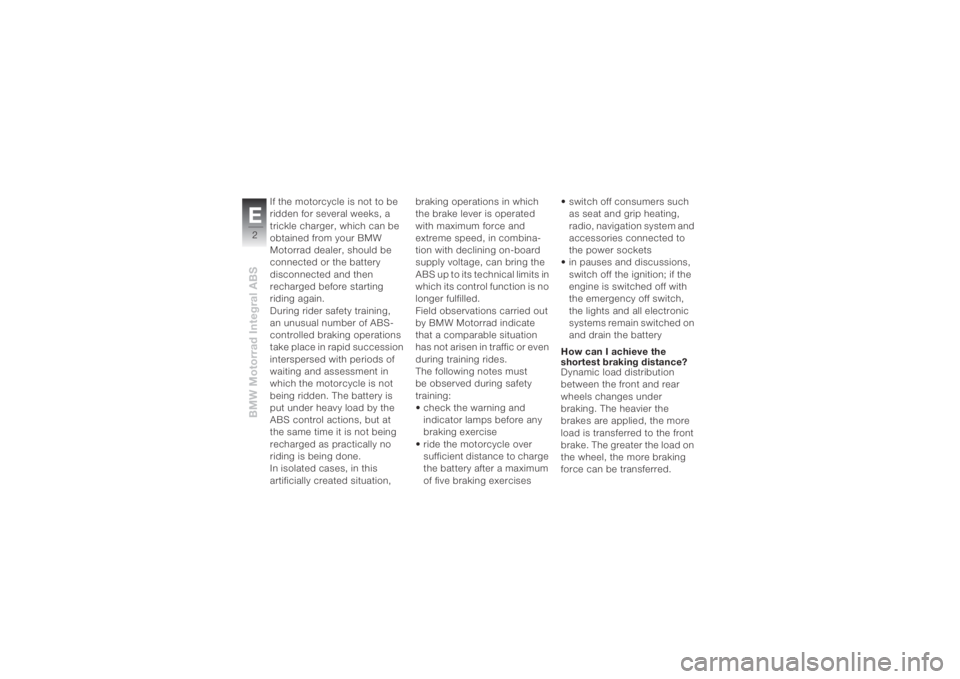Page 154 of 162

Indexi152
Luggage
Safety information, 50
Strapping, 42MMotorcycle equipment, 5
Multifunction display, 14NNeutral, telltale light, 18PParking light, 38
Bulb, 15
Replacing the bulb, 108
Parking your motorcycle, 61, 65
Power socket,9,74,136
Pre-ride check, 53RRear light, replacing the
bulb, 108
Rear shock absorber
adjustment, 9Rear spring preload
adjustment, 9
Rear wheel stand, 104
Replacement keys, 32
Resetting the odometer, 34
Residual braking function, 71
Residual range, 34
Restoring to use, 121
Rev. counter, 14
Rider’s equipment, 6
Running in
Brake pads, 58
General information, 58
SSafety check before a
journey, 52
Safety instructions, 50
Seat
Installing, 41
Lock, 9
Placing down, 40
Removing, 40Securing the steering lock, 31
Sensor for instrument cluster
lighting, 14
Shifting gear, 59
Side stand
Folding in, 63
Position on starting, 55
Unfolding, 61
Spark plugs, technical data, 135
Speed
Safety information, 50
Technical data, 138
Speedometer, 14
Splash guard, 116
Starter, 13
Starting, 56
Symbols, 4
TTechnical data
Bolt connections, 124
Dimensions and weights, 137
Electrical system, 135
Engine, 127
Page 159 of 162

E1BMW Motorrad Integral ABS
About BMW Motorrad Integral ABS
How does ABS work?
The maximum braking force
it is possible to transfer to the
carriageway depends, among
other things, on the road
surface's coefficient of friction.
Gravel, ice and snow, and
water on the road, have
significantly poorer coeffi-
cients of friction than a dry,
clean asphalt road surface.
The poorer the road's coeffi-
cient of friction, the longer the
braking distance.
If the maximum braking force it
is possible to apply to the road
is exceeded when the rider
increases brake pressure, the
wheels will begin to lock and
directional stability is lost; a fall
threatens. Before this situation
can arise, ABS intervenes and adapts the braking pressure to
the maximum braking force
it is possible to transfer so that
the wheels continue to turn
and driving stability is main-
tained whatever the prevailing
road conditions.
What happens with bumps
in the road?
Corrugated road surfaces or
bumps in the road can cause
the tyres to temporarily lose
contact with the road surface
and hence the braking force it
is possible to apply to drop to
zero. If the brakes are applied
in this situation, the ABS must
reduce the braking pressure to
ensure driving stability when
contact with the road surface
is restored. At this moment,
BMW Motorrad Integral ABS must assume extremely low
coefficients of friction (gravel,
ice, snow) so that the wheels
turn in any conceivable situa-
tion and thus the stability of
the motorcycle is ensured.
Once the actual circum-
stances are detected, the
system will set the brake pres-
sure to the optimum value.
What do we observe during
rider safety training?
Braking in which ABS has to
intervene has, by comparison
with normal braking, a signifi-
cantly higher demand for
electricity which puts a heavy
load on the battery. The
battery is constantly being
charged in normal riding so
that it always has sufficient
capacity available. Info_I_ABS_en_xx.fm Seite 1 Dienstag, 19. Juli 2005 2:48 14
Page 160 of 162

BMW Motorrad Integral ABSE2
If the motorcycle is not to be
ridden for several weeks, a
trickle charger, which can be
obtained from your BMW
Motorrad dealer, should be
connected or the battery
disconnected and then
recharged before starting
riding again.
During rider safety training,
an unusual number of ABS-
controlled braking operations
take place in rapid succession
interspersed with periods of
waiting and assessment in
which the motorcycle is not
being ridden. The battery is
put under heavy load by the
ABS control actions, but at
the same time it is not being
recharged as practically no
riding is being done.
In isolated cases, in this
artificially created situation, braking operations in which
the brake lever is operated
with maximum force and
extreme speed, in combina-
tion with declining on-board
supply voltage, can bring the
ABS up to its technical limits in
which its control function is no
longer fulfilled.
Field observations carried out
by BMW Motorrad indicate
that a comparable situation
has not arisen in traffic or even
during training rides.
The following notes must
be observed during safety
training:
• check the warning and
indicator lamps before any
braking exercise
• ride the motorcycle over
sufficient distance to charge
the battery after a maximum
of five braking exercises• switch off consumers such
as seat and grip heating,
radio, navigation system and
accessories connected to
the power sockets
• in pauses and discussions,
switch off the ignition; if the
engine is switched off with
the emergency off switch,
the lights and all electronic
systems remain switched on
and drain the battery
How can I achieve the
shortest braking distance?
Dynamic load distribution
between the front and rear
wheels changes under
braking. The heavier the
brakes are applied, the more
load is transferred to the front
brake. The greater the load on
the wheel, the more braking
force can be transferred.Info_I_ABS_en_xx.fm Seite 2 Dienstag, 19. Juli 2005 2:48 14
Page 161 of 162

E3BMW Motorrad Integral ABS
To achieve the shortest
braking distance, it is neces-
sary to apply the front brake
gradually and with increasing
force. This makes best use of
the dynamic increase in load
on the front wheel. At the
same time, the clutch should
be disengaged.
In emergency braking as it is
often taught, in which the
brake pressure is generated
as quickly as possible and with
all possible force, the dynamic
load distribution cannot follow
the increasing deceleration
and the braking force cannot
be completely transferred to
the road. The ABS has to
intervene to ensure that the
front wheel does not lock up;
this reduces the brake pres-
sure and the braking distance
is extended.What happens if ABS control
fails?
A fault in BMW Motorrad
Integral ABS is indicated by a
corresponding warning dis-
play in the instrument cluster.
If only ABS control fails, the
Integral system and the brake
servo action remain opera-
tional. If these systems also
fail, the residual brake function
is applied. In this case, the
forces to be applied to the
brake levers will be signifi-
cantly higher and the lever
travel required will be longer.
The residual brake function is
a mechanical function and is
always available in the event
of the failure of the BMW
Motorrad Integral ABS,
whatever the battery condi-
tion. It meets all requirements
of legislation around the world on the design of brakes for
motor vehicles and allows the
rider to brake the motorcycle.
The following notes must be
observed for riding with the
residual braking function:
• set the brake lever to
maximum travel
• always brake with both front
and rear brakes
• where it is safe to do so, try
out the brakes so that you
can learn the brakes'
response characteristics
• be aware of the prevailing
road conditions and adapt
your braking force
accordingly
• since this is an emergency-
run function, you should visit
a specialist workshop, or
better still a BMW Motorrad
dealer, as quickly as
possibleInfo_I_ABS_en_xx.fm Seite 3 Dienstag, 19. Juli 2005 2:48 14
Page 162 of 162
BMW Motorrad Integral ABSE4
What is the role of regular
maintenance?
Any technical system is
only ever as good as its
maintenance.
The service intervals specified
must be kept to without fail to
ensure that the BMW Motorrad
Integral ABS is in an optimum
maintenance condition.
What is the design
specification for BMW
Motorrad Integral ABS?
BMW Motorrad Integral ABS
ensures stability of the motor-
cycle on any surface within the
bounds of physics.
The system is not designed for
special requirements such as
those that arise under extreme
conditions of competition
off-road or on the racetrack.
��� ��������
��
� ���
� �� � ��� ���
���
�
���
������ �����
��
� ��!��
�����" ��#���
Info_I_ABS_en_xx.fm Seite 4 Freitag, 22. Juli 2005 10:17 10